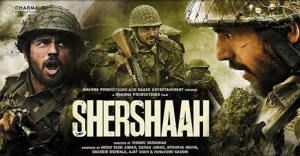Let’s talk about the obvious. An “Independence Day release is a neat idea, the hope being that more people will flock to see the movie.
Shershah is a bio-pic of Captain Vikram Batra who was awarded the Param Vir Chakra posthumously for his various actions during the 1999 Kargil War. The ferocity of the engagements can be seen from the fact that his unit the Jammu and Kashmir Rifles got two Param Veer Chakras, the other being Rifleman Sanjay Kumar, who survived to receive his medal. While making a biopic the problem becomes apparent – what is fiction, what is a fact, what is in between?
There is a long disclaimer at the beginning of the film about creative liberty and no insults intended to anyone. If we keep that disclaimer in mind, then the rest of the film falls into place. Rather than try to find out what is fact and what is fiction, we go along with Shershah on his journey from a small town to the final heights in the Kargil War.

So we are left with no choice but to treat the initial scenes of Batra growing up in a small town, vignettes of his “never say die” attitude, his pursuit of a small-town girl, the inevitable clash of religious beliefs on the girl’s side – all these have to be treated as the “filmy” stuff that we have seen in a thousand movies. The good part is its done in a low decibel way as compared to the “naheen” kind of scenes in the 60s and 70s, so familiar to film lovers
For a film that could have descended into jingoism and the odd “pro BJP” insert (though there is a small clip of PM Vajpayee and his speech of giving a fitting answer ), it is Batra’s actions on the hilltops of Kargil that redeems the film . The locales make the whole thing very realistic, including the exertions at the high altitude. For those who notice carefully, the hand signals used in combat, are accurate as are the weapons used in the war. There is some odd stuff that need not have been there like Batra being asked his lineage to which he proudly replies “my parents are teachers”. If this is to show the common origins of a warrior, then perhaps it could have been done better – it slightly smacks of ‘Army casteism’.
Batra on COIN (Counter Insurgency) operations emerges as a daredevil and it is here that the overall masala factor becomes apparent with a local Kashmiri youth lamenting their fate at being caught between the Indian army and the terrorists. His view that it’s better to die at the hands of the Army than the terrorists , is one of the few scenes of inadvertent comedy. Perhaps the intentions of the film-makers are honourable in that they don’t want the Kashmiris to be demonised but then it does descend into the good Muslim-bad Muslim trope, seen increasingly in a slew of films, dealing with the insurgency
The brotherhood of soldiers is something no civilian can understand, try as he might. In that context, it is but natural that the camaraderie and the backslapping appears a little overdone.
For those familiar with the mechanics of the Kargil war, frontal assaults were the rule than the exception as there were strict orders not to enter POK . This resulted in a higher than normal officer casualty rate.
At the end who was The Man behind the image is something that still remains a mystery. The film sticks to the tried and tested stories that are available in abundance. Perhaps, in the end, that’s the reality of the film – the myth is bigger than the man. As some cynical newspaperman said long ago, if the myth is bigger than the reality, print the myth. Shershah the film succeeds in that.
At the film’s end, some of Batra’s famous TV interviews in the middle of the war are shown, lending the film a more poignant aura
As always with war films, I would like to rate it on the following factors on a scale of 0 to 5
- History/reality – 4 (purely for the war scenes)
- Equipment and kit – 4
- Locations or substitutes – 4 (Kangra valley and other locales there substitute for Kargil)
- Masala Factor – 2
- Goof-ups – 4 (some odd uniforms, equipment – The Pakistanis use Indian machine guns!)
- Role of women – 2 (minimal and only in the romantic scenes)
- Music – 2 (totally unnecessary songs)
FINAL RATING – 3.2 out of 5
Leave a Reply
Want to join the discussion?Feel free to contribute!